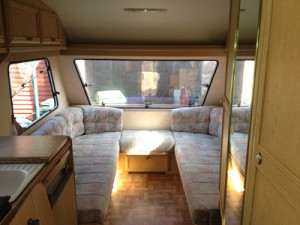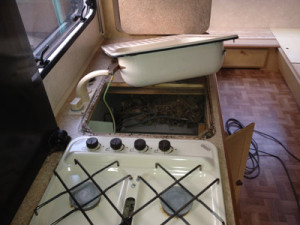-
Archives by Category
- Products (5)
- Campfire cooking (1)
- The Mighty Eagle (7)
- Activities (79)
- Foraging (16)
- Edible flowers (2)
- Treasure hunting (7)
- Summer (14)
- Fishing (8)
- Caravanning (1)
- Climbing (1)
- Fire lighting (5)
- Den making (6)
- Foraging (16)
- Featured (2)
- Recipes (22)
- Game (3)
- Foraging recipes (9)
- Fish recipes (3)
-
Archives by Month
- July 2015 (14)
- March 2013 (1)
- December 2012 (3)
- November 2012 (2)
- July 2012 (14)
- June 2012 (28)
- May 2012 (17)
- April 2012 (11)
- January 2012 (4)
- October 2011 (1)
Ebay is full of second caravans at this time of year. Some are bargains – others are damp boxes with wheels about to lose their integrity at the first sharp bend.
What to look for:
Have a look at this checklist, if you find one or two issues you can always barter down the price, given the work or costs involved to put right. Always think safety first, then the cost of the repairs. If it too much to fix, be prepared to walk away. Which is why you always need to visit and check what you are about to spend your money on. Be prepared to spend more than you think on repairs though.
Damp
This is the killer of caravans. The main framework inside a caravan is relatively thin 3×2″ wooden struts. If this has started to rot, you can often write off the caravan as a no hoper, unless you are prepared to do a lot of work rebuilding the frame. You can buy a damp tester for about £30 and it will be a great investment in the long run. Look for water ingress, damp smells or rotten panelling. Use your nail to push into the panelling; if it feels soft and spongey it is an indication that there may be a leak.
Most leaks happen at the joints between the sides of the caravan and roof. The aluminium rail which runs along the edges of most older caravans has a mastic (SikaFlex) join behind which can rot and pull out. To make sure your van is fully watertight, this should be stripped, cleaned and reapplied very few years. By the way this in itself is a long job!
Axles and frame
Check the axles to make sure that they are aligned and not out of shape. Wobbly wheels are a very expensive fix as most caravans are made on AlKo trailer frames. If you visit their site, you can get costs of replacement parts.
Gas
Gas powers the cooker, the heating and the fridge. Get these properly checked by a qualified engineer before you use. Yellow in the flames indicates deadly carbon monoxide. Also make sure it is fitted with a gas and carbon monoxide alarm.
Tyres
Check the tyres for wear and pressure. Most caravans have been standing around all year with their tyres rotting. Check for cracks in the walls of the tyres, and replace if necessary.
Electrics
Have a qualified electrician check the plugs and wiring, you never know, a mouse might have been lunching on some of the flex hidden in the walls.
Battery
Leisure batteries used in caravans are more expensive than your normal car batteries at around £70 for a replacement. If they are fully discharged they are ruined and might as well be tipped. Check that the battery is well maintained, and take a voltmeter to check that it is not dead. If possible it should be in a battery box and tied down securely.
Plumbing
Accept that the pump, pipes and toilet will need really good cleaning. Check the pump works by asking to run some water through (don’t run the pump dry). Pumps can be expensive to fix – £35 for a new external pump like a Whale, or up to £75 for an internal replacement.
Water heater/boiler
Check the water heater works, if it is gas it will also need an engineer to certify that it is safe. Electric heaters are cheaper at about £200 to replace. Gas ones are far more expensive.
Fridge
Most caravan fridges have a selector so you can choose how to power them. They will run off mains electricity, the battery/car or gas. Again it will need testing to make sure it is safe. A new one will set you back around £700, but you can buy a new small mains only electrical fridge for around £75, if you need to swap an old and broken one out.
Upholstery
The deal breaker will be the surroundings. Be prepared to recover all the existing chintzy furnishings, rip out carpets and replace with new cool looking fabrics. Even for a modest sized caravan, this could set you back £300.
The purchase
Make sure you haggle down. You will always find faults that the eBay seller doesn’t want you to know about. So make sure you go with your research about what the cost of some basic repairs will be.
The drive away
Before you drive your new van to its destination, do a quick check of what you will need:
• Does your driving license allow towing?
• Check the route – any low or narrow bridges? For your first time avoid any difficult roads.
• What power hook up connects your car to the van? Some newer models use one single connector rather than two black and grey ones. The black connector powers brake lights, whereas the grey one charges the internal battery of the caravan and fridge if you have it selected. If you need a converter you can buy them from Halfords for about £30
• Check the brake lights, indicators and running lights. They all need to be working before you pull off.
• Check tyres/ pressure / tread
• Check the connection to the tow hook is solid.
• Connect the emergency break cable (little red cable) to your tow bar
• Wind up any wheels / stands and make sure the jockey wheel has been unscrewed and pulled up to its highest amount.
• Turn off any gas and disconnect the supplies from the bottles. Also close any switches or gas selectors.
• Open the curtains – helps you see through the caravan
• Turn off and unplug the mains electrics
• Open any taps and take the plugs out of the sinks, so any water in the lines will drain out
• Un hook any connectors
• If you have things in the van, put most of the weight slightly forward of the axle. Don’t have anything that is heavy high up as it will make the caravan unstable.
• Lock the caravan
• Check your mirrors and move off slowly.
• Drive at no more than 60 mph (it’s the law)
• Don’t accelerate, turn or brake suddenly. Your driving needs to be smooth, so look well ahead for potential issues and anticipate well in advance.
• Bear in mind your car will not stop quickly, nor will it handle the same. Act like a truck. Stay in the left hand lane and only overtake when you really need to.
• Don’t ever go in the outside lane on a motorway – that’s against the law too.
• As you are now a truck, flash to let other trucks in and respond to trucks flashing you in with a waggle of the indicators in thanks.
Enjoy your new purchase and keep on trucking!





